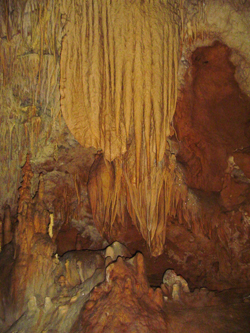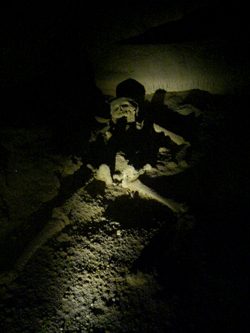By Mark Campbell
The skeleton was on its back. I wondered how the woman would have felt as she was led—willingly? fearfully? proudly?—through the black cavern and sacrificed to appease Chac, the god of rain.
“Actun Tunichil Muknal means cave of the stone sepulcher,” our guide had explained as we stood before the dark hourglass mouth of the cave 45 minutes earlier. “To get to the skeletons we must swim into the entrance. Then we must wade. Sometimes the water is waist deep, sometimes chest deep. There are bats.”
The skeleton was on its back. I wondered how the woman would have felt as she was led—willingly? fearfully? proudly?—through the black cavern and sacrificed to appease Chac, the god of rain.
“Actun Tunichil Muknal means cave of the stone sepulcher,” our guide had explained as we stood before the dark hourglass mouth of the cave 45 minutes earlier. “To get to the skeletons we must swim into the entrance. Then we must wade. Sometimes the water is waist deep, sometimes chest deep. There are bats.”
Belize is rich in Mayan culture, and Actun Tunichil Muknal is one of the most fascinating sites. Tom Miller was exploring Belize’s massive cave systems in 1986 when he discovered a ceremonial site that had not been touched since the last shaman walked out of it in the tenth century AD. Tourists can see the entire site almost exactly as it was then.
A beautiful stream flows out of the cave and fish harmlessly nip our toes as we take a dip to cool off before entering the cave where Mayan priests once made offerings to their gods, including human sacrifices.
Soon the light from the entrance has faded to nothing. It is pitch black and we have 30 minutes to go. We have flashlights and a guide, but it must have been a very different journey for the Mayans, who believed that the cave was an entry to the underworld.
Mayans, who believed that the cave was an entry to the underworld.
Glistening limestone bulges and curtains ooze from the walls in whites, browns, grays and reds. Stalactites descend from the roof. Our guide explains: “The Mayans believed that stalactites are the roots of the world tree, the sacred ceiba. Its roots grow in Xibalba, the underworld, and its branches form the heavens.”
After passing some large cave spiders, we reach the comparatively dry archaeological site. Now we walk in socks to avoid damaging the site either with our hard shoes or our oily feet.
Caves were sacred to the Mayans, and that feeling lingers still. Pottery is scattered everywhere, broken at the conclusion of a religious ceremony to release the spirit of the offering. Even with just one flashlight scanning the floor, the half-buried pots are an amazing sight. So many prayers, so many offerings, caught in time. A skull lies on the surface of the clay.
Carefully avoiding artifacts we continue up the second chamber where two skeletons have been mixed together. The bones are slowly turning to stone, coated by calcium carbonate.
The third chamber is aptly named the cathedral. Stalactites form magnificent pillars and chandeliers. A ladder leads to another chamber, accessible only through a very narrow gap between rocks.
Entering this final chamber, we see more ceramics. Then, through a narrow passage the cave system culminates in another sacrifice, a woman. Her skeleton is clearly recognizable but heavily coated in white calcium carbonate. The cave gets its name from her, for her skeleton is now more stone than bone. Nearby lays a child’s skull, grossly distorted now by its mineral encrustation. Were these the final desperate sacrifices?
coated in white calcium carbonate. The cave gets its name from her, for her skeleton is now more stone than bone. Nearby lays a child’s skull, grossly distorted now by its mineral encrustation. Were these the final desperate sacrifices?
No one knows the real story behind these sacrifices, but the Mayans suffered a terrible drought at the time, and it is easy to imagine them taking ever more desperate actions to satisfy their gods. As the drought worsened, shamans ventured further into the underworld and made ever more valuable offerings, finally including people, probably to Chac, the rain god. Perhaps the victims went willingly, proud to be chosen to save their people. But it didn’t work. The cave was abandoned about the same time as the collapse of the great Mayan centers elsewhere.
The story must have been repeated many times in a civilization of many millions of people, with no hope but to appease unhappy gods.
While there are skeletons, and it is an adventure, this is not Raiders of the Lost Ark. Instead, the cave of the stone sepulcher provides a moving insight into one of the world’s great civilizations. We followed a trail of ancient ceremonies but, unlike the Mayans, we all came back.
If you go:
For more about the cave of the stone sepulcher:
http://ngm.nationalgeographic.com/ngm/0411/feature2/fulltext.html
http://www.archaeology.org/online/features/belize/tunichil.html
Tours are only possible with licensed guides and many operations can connect you. Tours should cost around $80. Some places to try are:
http://www.mayawalk.com/html/actun.html
http://www.cavesbranch.com/adventures/caving.html
For general information about Belize see the official website of the Board of Tourism:
http://www.travelbelize.org
If you wish to purchase this article for your publication, click here to contact the author directly.
A beautiful stream flows out of the cave and fish harmlessly nip our toes as we take a dip to cool off before entering the cave where Mayan priests once made offerings to their gods, including human sacrifices.
Soon the light from the entrance has faded to nothing. It is pitch black and we have 30 minutes to go. We have flashlights and a guide, but it must have been a very different journey for the
 Mayans, who believed that the cave was an entry to the underworld.
Mayans, who believed that the cave was an entry to the underworld.Glistening limestone bulges and curtains ooze from the walls in whites, browns, grays and reds. Stalactites descend from the roof. Our guide explains: “The Mayans believed that stalactites are the roots of the world tree, the sacred ceiba. Its roots grow in Xibalba, the underworld, and its branches form the heavens.”
After passing some large cave spiders, we reach the comparatively dry archaeological site. Now we walk in socks to avoid damaging the site either with our hard shoes or our oily feet.
Caves were sacred to the Mayans, and that feeling lingers still. Pottery is scattered everywhere, broken at the conclusion of a religious ceremony to release the spirit of the offering. Even with just one flashlight scanning the floor, the half-buried pots are an amazing sight. So many prayers, so many offerings, caught in time. A skull lies on the surface of the clay.
Carefully avoiding artifacts we continue up the second chamber where two skeletons have been mixed together. The bones are slowly turning to stone, coated by calcium carbonate.
The third chamber is aptly named the cathedral. Stalactites form magnificent pillars and chandeliers. A ladder leads to another chamber, accessible only through a very narrow gap between rocks.
Entering this final chamber, we see more ceramics. Then, through a narrow passage the cave system culminates in another sacrifice, a woman. Her skeleton is clearly recognizable but heavily
 coated in white calcium carbonate. The cave gets its name from her, for her skeleton is now more stone than bone. Nearby lays a child’s skull, grossly distorted now by its mineral encrustation. Were these the final desperate sacrifices?
coated in white calcium carbonate. The cave gets its name from her, for her skeleton is now more stone than bone. Nearby lays a child’s skull, grossly distorted now by its mineral encrustation. Were these the final desperate sacrifices?No one knows the real story behind these sacrifices, but the Mayans suffered a terrible drought at the time, and it is easy to imagine them taking ever more desperate actions to satisfy their gods. As the drought worsened, shamans ventured further into the underworld and made ever more valuable offerings, finally including people, probably to Chac, the rain god. Perhaps the victims went willingly, proud to be chosen to save their people. But it didn’t work. The cave was abandoned about the same time as the collapse of the great Mayan centers elsewhere.
The story must have been repeated many times in a civilization of many millions of people, with no hope but to appease unhappy gods.
While there are skeletons, and it is an adventure, this is not Raiders of the Lost Ark. Instead, the cave of the stone sepulcher provides a moving insight into one of the world’s great civilizations. We followed a trail of ancient ceremonies but, unlike the Mayans, we all came back.
If you go:
For more about the cave of the stone sepulcher:
http://ngm.nationalgeographic.com/ngm/0411/feature2/fulltext.html
http://www.archaeology.org/online/features/belize/tunichil.html
Tours are only possible with licensed guides and many operations can connect you. Tours should cost around $80. Some places to try are:
http://www.mayawalk.com/html/actun.html
http://www.cavesbranch.com/adventures/caving.html
For general information about Belize see the official website of the Board of Tourism:
http://www.travelbelize.org
If you wish to purchase this article for your publication, click here to contact the author directly.

